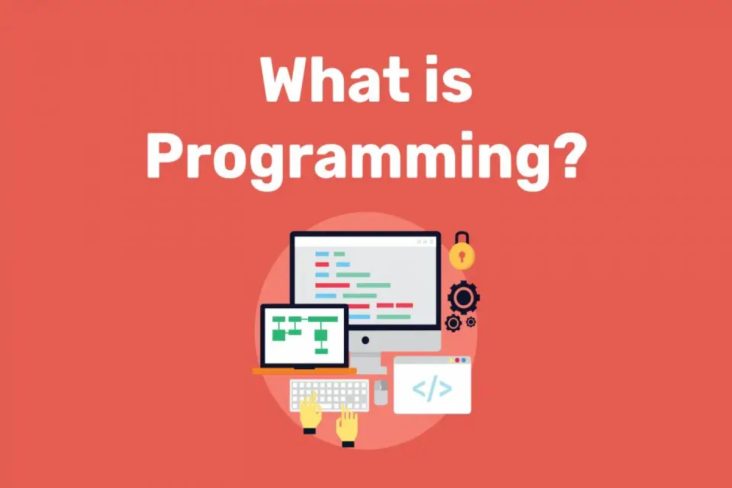Introduction
What Is Programming – Let’s start with a modest software design definition. Programming tells a computer to do a task. It can range from simple tasks like finding the sum of two numbers to solving complex problems like driving a self-driving car.
Now that we have defined programming let’s think about where it fits into the modern world. It’s safe to say that it remains intertwined with our everyday lives in more ways than we probably know.
The use of programming to make life easier can do found in almost every area of life, including business, entertainment, transportation, medicine, agriculture, sports, and politics.
What Is Programming Language?

A programming language is a computer philologist used by developers to specify the behaviour of a computer, application, or software program written in a specific language to perform a particular task. It languages remain used to write computer programs. Following are the most popular of these languages −
Java: It is a high-level, object-oriented, general-purpose and they language. It remains used for building standalone, enterprise, mobile, and web applications. Java code can run without recompilation on any platform that supports this language.
Python: It is also a general-purpose, high-level language that features large indentation and easy-to-read code and many programming paradigms.
Child: It is a general-purpose they language with device drivers, operating systems, and applications in protocol stacks. However, the use of the C language is declining due to its inefficiency.
C++:It is a general-purpose, high-level language used by many applications and software. It has object-oriented and functional features in addition to low-level memory manipulation.
Assembly language: The language remains designed to be human-readable. It is a low-altitude programming language that communicates directly with computer hardware. There is a strong correspondence between architectural machine instructions and language instructions.
JavaScript: It is one of the most basic programming languages on the World Wide Web. It is a high-level, just-in-time compiled language that conforms to the ECMAScript standard. The speech comes with dynamic typing, first-class features, and prototype-based object orientation.
PHP: It is an open-source general-purpose scripting language used by programmers for web development. It consists of HTML with embedded code.
Why Is Programming Important to Your Organization?
It skills are required regardless of whether you have a website or application, regardless of IT or non-IT. Benefits an organization can gain from it:
- Increased productivity
- Improve communication across the company
- Improve business processes
- Improve informed decision making
- Enable organizations to assess human resources effectively
- save money
Techopedia Explains – What Is Programming?
A programmer can work in a variety of environments, from small businesses to large IT companies, and be involved in all components related to system it, such as:
- System conception and design
- System development
- write code
- Test
- Debug
- Implementation
- Maintenance
- System instruction or program
Programmers work under the direction of a Systems Analyst or Lead Programmer. After completing the design of a program, programmers translate that design into a set of codes or instructions that can be executed and executed by a computer using a particular programming language and required platform. After converting the design to code, programmers run the code and check for bugs and errors. If the programmer finds a code error, the proper fix is applied, and the program remains rerun. Programmers try to perfect their code through a process of trial and error until an acceptable level of error does reach, and this process continues throughout the life of the program.
Who Should Take a Programming Course or Certification?
Anyone can take an online course or certification in computer programming. The minimum requirement for such a degree is a bachelor’s degree, but introductory they courses are available to graduate students of all majors and levels. Students can attend advanced programming courses only after completing a basic certification.
Future of What Is Programming?
The world of technology is evolving rapidly. Today, nearly every industry uses the latest technology to improve processes and use resources effectively. To smoothly adapt to technological change, companies are looking for professionals who understand and can handle the complexities of new technologies.
The emergence of new technologies such as machine learning, IoT, virtual reality and robotics will pave the way for new types of it environments in the future. Languages such as R, Go, Kotlin, Python, Scala, C#, and TypeScript remain touted as the future programming languages. Mastering these programming languages will improve your technical skills and open up more job opportunities. Programming is one of the most prestigious and highest-paid fields. To be successful in this field, software developers and other computer professionals must be familiar with today’s primary programming languages.
Conclusion
What Is Programming – As programming becomes a part of our lives, everyone needs to understand what programming is and how it remains used. Programming is essential to our careers, but it also plays a critical role in how we participate in politics, buy things, and connect. Learning to code is an exciting journey. Whether you’re building mobile apps, searching databases, or coding robots, coding is a life-advancing skill.




GIPHY App Key not set. Please check settings